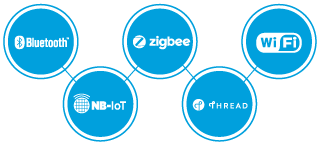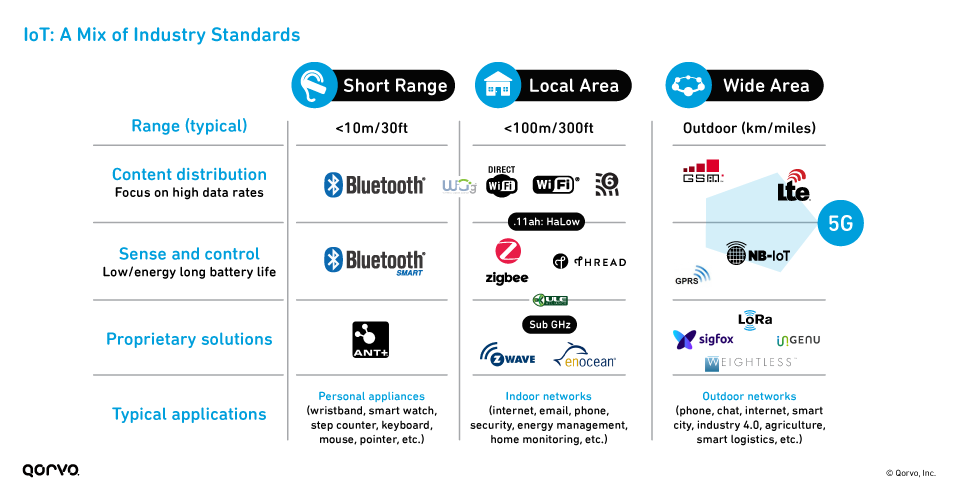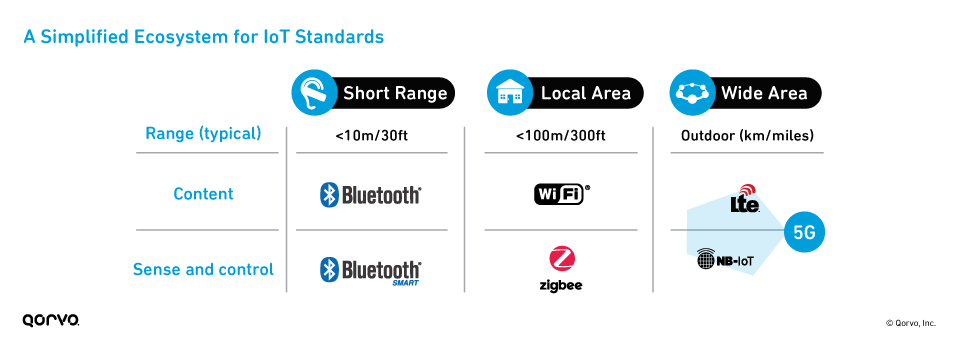IoT Standards: The End Game
April 8, 2019
 Quite regularly I get the
question: With all these standards around, what should I choose? Zigbee®,
Thread, Bluetooth®, or Wi-Fi technology? Or maybe LoRa™? Or is it better to wait for
5G and
NB-IoT?
Quite regularly I get the
question: With all these standards around, what should I choose? Zigbee®,
Thread, Bluetooth®, or Wi-Fi technology? Or maybe LoRa™? Or is it better to wait for
5G and
NB-IoT?
Of course, these questions create confusion and slow down the adoption of the Internet of Things (IoT). Part of this confusion is because it isn’t always clear what standards are suitable, as shown in the figure below. In addition, marketers make unsubstantiated claims about new standard capabilities like latency (“in the milliseconds!”), as if that’s really important. Not so. Most applications can deal with a latency of seconds; even live TV delayed a few seconds is still live TV.

So, how does one answer the question, “What standard should be used?” Usually, I answer this question with, “How can you make money?” Typically, the determining factor isn’t the radio standard. For radio, most apply “good enough is good enough,” and making money is determined by the value created by the application that runs over wireless. Wireless is just wireless, like a wire is just a wire.
And keep in mind: Whatever wireless standard is leading the pack today, in 5-10 years things will have changed anyway, so upgrading your network will be important. But waiting for “the final and ultimate” wireless networking technology will take a long time.
Nevertheless, can we peer into the future and develop a sense of where
things are going? I believe we can, but first, let’s create some
perspective.
The relation of technology and psychology
Our smartphones have three radios (4G, Wi-Fi and Bluetooth technology). Why three, and not two (like a tablet), or one, or four? There is a reason — and it’s linked to technology, as well as the psychology of how we experience our living space. Let me explain.
First, technology. Three factors largely determine the performance of a radio:
- Range (how far away you are from a base station — cell tower, router, hotspot, etc.)
- Data rate (from a simple voice call to watching video)
- Battery life (the longer the better)
The fourth factor is usually cost, with a simple mantra: “more is more
expensive.” In other words, more range is usually more expensive; the
same thing applies to higher data rates and longer battery life. Technically,
however, everything is possible and you could have only one radio; it
isn’t necessarily cost-effective, but you can.
Here’s an extreme example. Imagine listening to a piece of music on your cell phone with a cordless Bluetooth headset, where the headset connects directly to the phone and isn’t connected to the cellular network. However, technically it would be possible to connect both the phone and the headset to the cellular network and have the music running over the cellular network from your phone to your headset.
Or another example: When you print a document at home from your computer to your Wi-Fi printer, do you think this document goes directly through the air from your computer to the printer? Technically this is possible (e.g., with a Bluetooth or Wi-Fi Direct connection), but it’s also possible that it goes via Wi-Fi to your home router, and from your home router via Wi-Fi to your printer. It’s also possible that the print command goes to the cloud, and the document is printed directly from your cloud server over the cable (or fiber) network to your home router, and then is transferred wirelessly to the printer. There are many ways this can be organized over wired and wireless networks — and frankly, we’ve lost track, and the details have become irrelevant. As long as it works, everyone is fine.
Secondly, how do we experience space? This has less to do with technology and more with psychology. On the smallest level, we first experience a personal space. Did you ever have a conversation with someone who came too close to your face, and you started to feel uncomfortable? If so, you understand what I mean with “personal space.” It’s the flexible bubble around you, wherever you are, and its size varies; if you’re squeezed into a busy metro, this space is much smaller than, say, when you’re in a restaurant or in an office.
We also experience a spatial situation in which we can reach with our voice or, to a certain extent, with our vision. This could be at home or the office. It is private territory, compared to the world outside. We sometimes distinguish this space by calling it indoor versus outdoor, or private versus public.
And last but not least, there is the outdoor, public space — owned and regulated by the government.
If you translate these three spaces back to the three radios in our phone, there is some continuity: a Bluetooth radio for our personal space (our bubble), Wi-Fi for our private space, and 3G/4G and soon 5G for access in the public space. Coincidence? Probably not. Whoever was involved in the “war of standards” knows there was no higher committee deciding how to nicely split up different radios and standards over these three spaces. It just fell into place.
In the past 20-30 years, every standard has battled for maximum usage space
— and some of these battles are still going on today. 5G, the next
public space standard, is claiming that it works well indoors and may make
Wi-Fi redundant. Bluetooth technology initially made serious claims for the Wi-Fi indoor
market (never successful), while Wi-Fi has been eyeing the Bluetooth market
with Wi-Fi Direct. Although Wi-Fi Direct isn’t dominantly successful, it
isn’t dead either — for drones, Wi-Fi Direct has found an
interesting niche.
Extending the concept to IoT standards
So, at least for now, we have learned to be comfortable with the three-radio concept in our phone and how they seamlessly connect to how we experience “space.” But how do we deal with the plethora of low-power IoT standards? The first goal is to understand the marketplace of low-power standards.
The real focus of these low-power standards is on long battery life — not data rates — without compromising range. Usually, low-power standards are used to connect devices (e.g., sensors) to the internet (IoT) for the purpose of sharing sensor data, and the data rate required for this is orders of magnitude lower than for “normal” internet usage or watching videos. So, essentially low-power standards exchange data rate for battery life.
Interestingly, these low-power standards start to rally around the same three ranges mentioned earlier:
- For our personal space: Low-power Bluetooth technology (sometimes called Bluetooth Low Energy)
- For our private space (such as home, office or hotspot): Zigbee (IEEE 802.15.4), which is essentially a low-power Wi-Fi standard
- For the public space: NB-IoT/Cat-X as part of 4G/5G
So, there is a possible answer to where all these standards could be going and
simplifying the discussions that are going on in the industry:

This low-power/sense-and-control alignment makes all the sense in the world
because it lines up with how we experience space, as well as the three radios
in our smartphone.
What does this mean for the future?
However, nothing is for sure, and looking into the future is a dicey job. Technologies continue to try venturing into “other spaces,” and there are several initiatives going on in the market. These can vary from ways to maximize the reuse of existing technology, or trying to answer simple questions (like, can NB-IoT/Cat-X also be used for indoor networks?). Similarly, there’s an effort to expand Bluetooth Low Energy into the networking space and adding meshing capabilities to displace Zigbee — in the same way that Bluetooth technology tried to displace Wi-Fi around 20 years ago. These efforts may not be successful, but nevertheless, big companies are spending serious dollars on them.
One interesting note is that there may be a fourth domain, between the
local area (indoor) and the wide area (public). There are large outdoor spaces
that are still semiprivate, such as campuses, harbors, airports and convention
centers. So, the question may be: Do we need another standard that is focused
on this domain “in between”? The future will tell. Maybe the
existing standards are flexible (and cost-effective) enough to serve this
space well, or an emerging standard will be better qualified. In this respect,
it’s interesting to see that LoRa, as a pseudo standard for outdoor, is
very visible in this zone between private and public, in harbors and
airports.
Open vs. proprietary standards
This leads me to mention the role between open standards and proprietary standards. History has shown so far that open communication standards are more successful than closed standards. Wi-Fi has pushed HomeRF out of the market; similarly, Bluetooth Low Energy pushed out ANT+.
But other standards are still battling, such as Zigbee, Thread and Z-Wave
(Silicon Labs). However, Zigbee and Thread standards are both based on the open IEEE
802.15.4 standard (just as Wi-Fi is based on IEEE 802.11), while Z‑Wave is
proprietary and closed. It’ll be interesting to see which will come out
on top, but most likely it will be a converged Zigbee/Thread interface; they already use
the same application layer software (Dotdot), and their only difference is
network layer software.
High data rate vs. low power
For standards venturing into other areas, it’s also interesting to mention that the boundary between Wi-Fi (high data rate) and Zigbee (low power) is not very hard either. From an application space perspective, there are applications that require higher data rates and, at the same time, need to run on batteries, thus requiring low power.
For some time now, significant efforts are ongoing to make Wi-Fi truly low
power. The IEEE 802.11ah effort is one example, although it doesn’t
seem to go anywhere because it’s operating in sub-GHz bands, which lack
uniformity; different radio technologies are required in different areas in
the world. However, true low-power implementations of Wi-Fi 4 (.11n) and
Wi-Fi 5 (.11ac) might be interesting alternatives for Zigbee technology, if they
reach low enough power — in other words, long enough
battery life.
The takeaway
This is all to be seen, and interesting to follow for everyone who is in the radio development space. However, it doesn’t change the situation mentioned earlier: ultimately the usefulness of the application creates the value for the end user, not the wireless wire. Time will only tell which standards will be the most successful, but waiting for it probably won’t be useful if you know how to make money now.
Have another topic that you would like Qorvo experts to cover? Email your suggestions to the Qorvo Blog team and it could be featured in an upcoming post. Please include your contact information in the body of the email.
